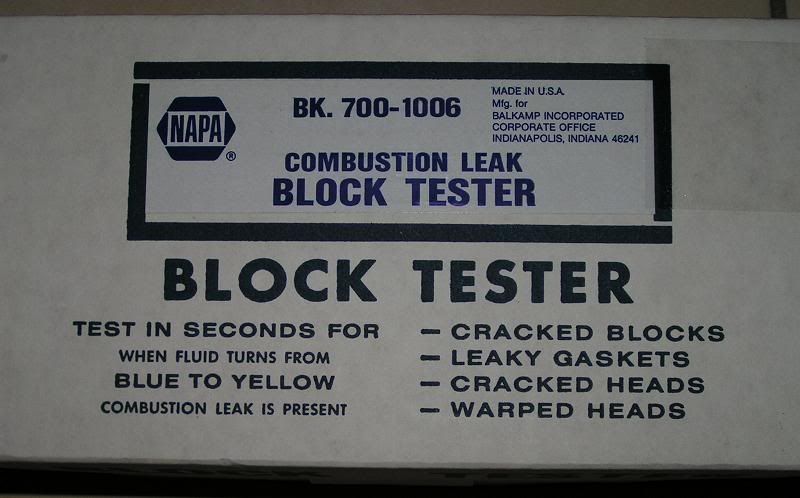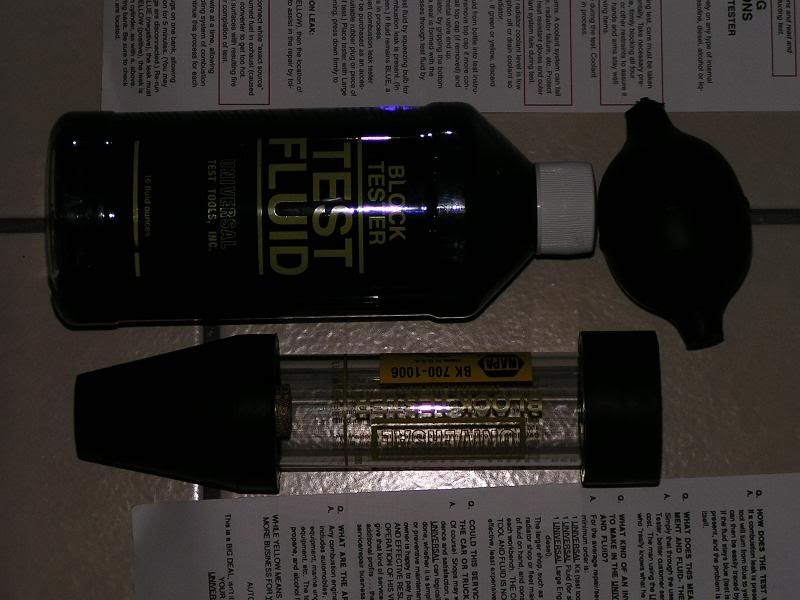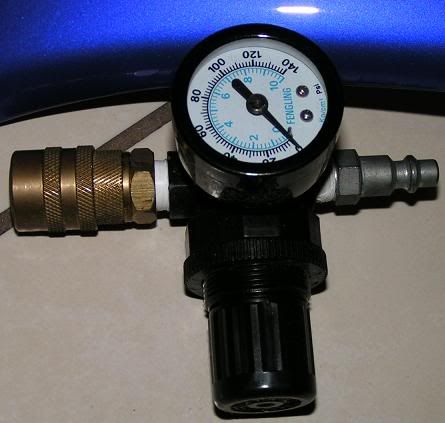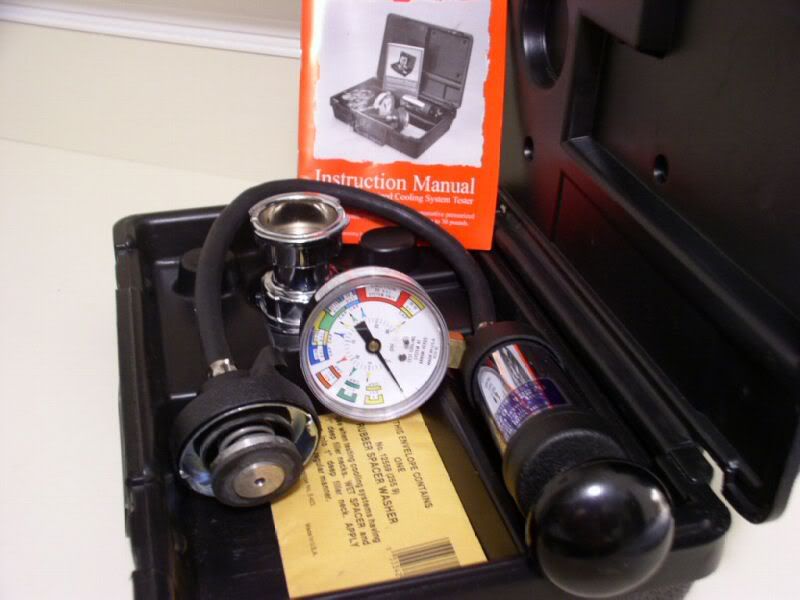Diagnosing a Blown Head Gasket & Precautionary Measures
There are three types of blown head gaskets common to the MKIII. The following paragraphs will explain each & tell you how to detect different ones as well.
(1) CYLINDER TO WATER JACKET LEAK TYPE
Symptoms: Overheating, temperature gauge spikes, constantly losing coolant, and water gurgling sounds upon startup.
One way to see if you this leak is to have a BLOCK TEST performed (see pics 1&2). The way this test checks for a leak is by “sniffing” hydro carbons in the coolant from the radiator neck. If the color of the liquid in the tester changes, it means that exhaust gases from a cylinder/s are entering into the coolant passages.
Another way to analyze this type of leak is to take the overflow hose, that EXITS the coolant reservoir, and place it into an outside container such as a soda bottle or so.
If the coolant you are losing from your system get placed into that container, it means that the hi pressured combustion gasses are pushing the cooling out of the motor, into the reservoir, and then out of the reservoir & into the placed container.
Duane (upgradedsupra) taught us this trick in an SF thread. So credit goes to him for this paragraph.
Temperature spikes with the temperature gauge are an indication of an intermittent leak. This is a leak that happens on & off. As hot combustion gasses leak into the system, the gauge will read the scorching combustion gasses leaking from the cylinders. Being that the gas is hotter than the temperature of the coolant, you will see the gauge skyrocket towards HOT. If you let off of the gas, you will notice that the temperature will decrease since little pressure & combustion occur at closed throttle.
Some do test this leak with a compression tester as well. Keep in mind that a leak may not show up until higher pressures occur, such as the pressures that are produced with combustion. Keep in mind: combustion pressure>>>>>compression pressure.
A leak down tester (see pic 3) can also be utilized but has some of the same disadvantages as a compression tester (does not diagnose intermittent leaks or leaks that only occur during high cylinder pressure). If you perform a leak down test & see coolant flowing into the reservoir, or coolant coming out of the radiator if the cap is off, you know you have a leak.
Info on how to do a leak down test can be obtained by the following thread by me
http://supramania.com/forums/showthread.php?t=2229
One other way to check this is to use a Coolant System Pressure Tester (see pic 4). Again, the pressure involved with this tester (low double digits) may not be enough to show up anything unless the gasket is really bad.
Continual use of a vehicle with this type of leak will warp the aluminum head. There have also been cases of blocks cracking possible due to the pressure caused by the head warping & then lifting up on the middle head bolt hole in the block. I have had this happen to me.
Please keep in mind that cars can overheat or lose coolant for reasons other than a blown head gasket. See the following links for other possibilities of overheating or loss of coolant. It is advisable to look into the easier fixes before tackling the head gasket replacement:
http://supramania.com/forums/showthread.php?t=590
http://supramania.com/forums/showthread.php?t=1097
(2) OIL PASSAGES TO WATER JACKET LEAK TYPE
Symptoms: Foamy milkshake looking oil, oily film in the radiator filler neck or coolant reservoir.
Basically to diagnose this, just look at your fluids and check for those signs.
Neither a compression test or nor a leak down test will indicate anything here, as the leak does not have anything to do with the combustion chamber.
Continual use of a vehicle with this type of BHG will contaminate & compromise the oil, & cause you to need to change your bearings. If you upset bearings this way, rod knock may be your next problem.
(3) CYLINDER TO CYLINDER TYPE LEAK
The best way to diagnose this type of leak is to do a leak down test.
Basically, you will have all spark plugs out. If you can hear or feel air coming out a spark plug hole of an adjacent cylinder to the cylinder being tested, you have a leak. To verify this all you have to do is perform a leak down test on the adjacent cylinder that blew out air. You will find that the cylinder that originally showed the leak will now be blowing air out of its spark plug hole.
http://supramania.com/forums/showthread.php?t=2229
A compression test can also indicate this. Look for two low readings in adjacent cylinders. You won’t have the benefit of hearing or feeling the air leaking out of the spark plug holes as you will with a leak down test though.
Block Tester Box

Block Tester

Leak Down Tester - how to make it & use it here--> http://supramania.com/forums/showthread.php?t=2229

Coolant System Pressure Tester

There are three types of blown head gaskets common to the MKIII. The following paragraphs will explain each & tell you how to detect different ones as well.
(1) CYLINDER TO WATER JACKET LEAK TYPE
Symptoms: Overheating, temperature gauge spikes, constantly losing coolant, and water gurgling sounds upon startup.
One way to see if you this leak is to have a BLOCK TEST performed (see pics 1&2). The way this test checks for a leak is by “sniffing” hydro carbons in the coolant from the radiator neck. If the color of the liquid in the tester changes, it means that exhaust gases from a cylinder/s are entering into the coolant passages.
Another way to analyze this type of leak is to take the overflow hose, that EXITS the coolant reservoir, and place it into an outside container such as a soda bottle or so.
If the coolant you are losing from your system get placed into that container, it means that the hi pressured combustion gasses are pushing the cooling out of the motor, into the reservoir, and then out of the reservoir & into the placed container.
Duane (upgradedsupra) taught us this trick in an SF thread. So credit goes to him for this paragraph.
Temperature spikes with the temperature gauge are an indication of an intermittent leak. This is a leak that happens on & off. As hot combustion gasses leak into the system, the gauge will read the scorching combustion gasses leaking from the cylinders. Being that the gas is hotter than the temperature of the coolant, you will see the gauge skyrocket towards HOT. If you let off of the gas, you will notice that the temperature will decrease since little pressure & combustion occur at closed throttle.
Some do test this leak with a compression tester as well. Keep in mind that a leak may not show up until higher pressures occur, such as the pressures that are produced with combustion. Keep in mind: combustion pressure>>>>>compression pressure.
A leak down tester (see pic 3) can also be utilized but has some of the same disadvantages as a compression tester (does not diagnose intermittent leaks or leaks that only occur during high cylinder pressure). If you perform a leak down test & see coolant flowing into the reservoir, or coolant coming out of the radiator if the cap is off, you know you have a leak.
Info on how to do a leak down test can be obtained by the following thread by me
http://supramania.com/forums/showthread.php?t=2229
One other way to check this is to use a Coolant System Pressure Tester (see pic 4). Again, the pressure involved with this tester (low double digits) may not be enough to show up anything unless the gasket is really bad.
Continual use of a vehicle with this type of leak will warp the aluminum head. There have also been cases of blocks cracking possible due to the pressure caused by the head warping & then lifting up on the middle head bolt hole in the block. I have had this happen to me.
Please keep in mind that cars can overheat or lose coolant for reasons other than a blown head gasket. See the following links for other possibilities of overheating or loss of coolant. It is advisable to look into the easier fixes before tackling the head gasket replacement:
http://supramania.com/forums/showthread.php?t=590
http://supramania.com/forums/showthread.php?t=1097
(2) OIL PASSAGES TO WATER JACKET LEAK TYPE
Symptoms: Foamy milkshake looking oil, oily film in the radiator filler neck or coolant reservoir.
Basically to diagnose this, just look at your fluids and check for those signs.
Neither a compression test or nor a leak down test will indicate anything here, as the leak does not have anything to do with the combustion chamber.
Continual use of a vehicle with this type of BHG will contaminate & compromise the oil, & cause you to need to change your bearings. If you upset bearings this way, rod knock may be your next problem.
(3) CYLINDER TO CYLINDER TYPE LEAK
The best way to diagnose this type of leak is to do a leak down test.
Basically, you will have all spark plugs out. If you can hear or feel air coming out a spark plug hole of an adjacent cylinder to the cylinder being tested, you have a leak. To verify this all you have to do is perform a leak down test on the adjacent cylinder that blew out air. You will find that the cylinder that originally showed the leak will now be blowing air out of its spark plug hole.
http://supramania.com/forums/showthread.php?t=2229
A compression test can also indicate this. Look for two low readings in adjacent cylinders. You won’t have the benefit of hearing or feeling the air leaking out of the spark plug holes as you will with a leak down test though.
Block Tester Box

Block Tester

Leak Down Tester - how to make it & use it here--> http://supramania.com/forums/showthread.php?t=2229

Coolant System Pressure Tester

